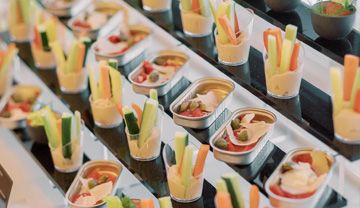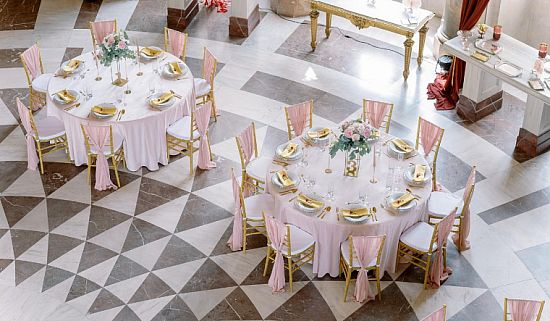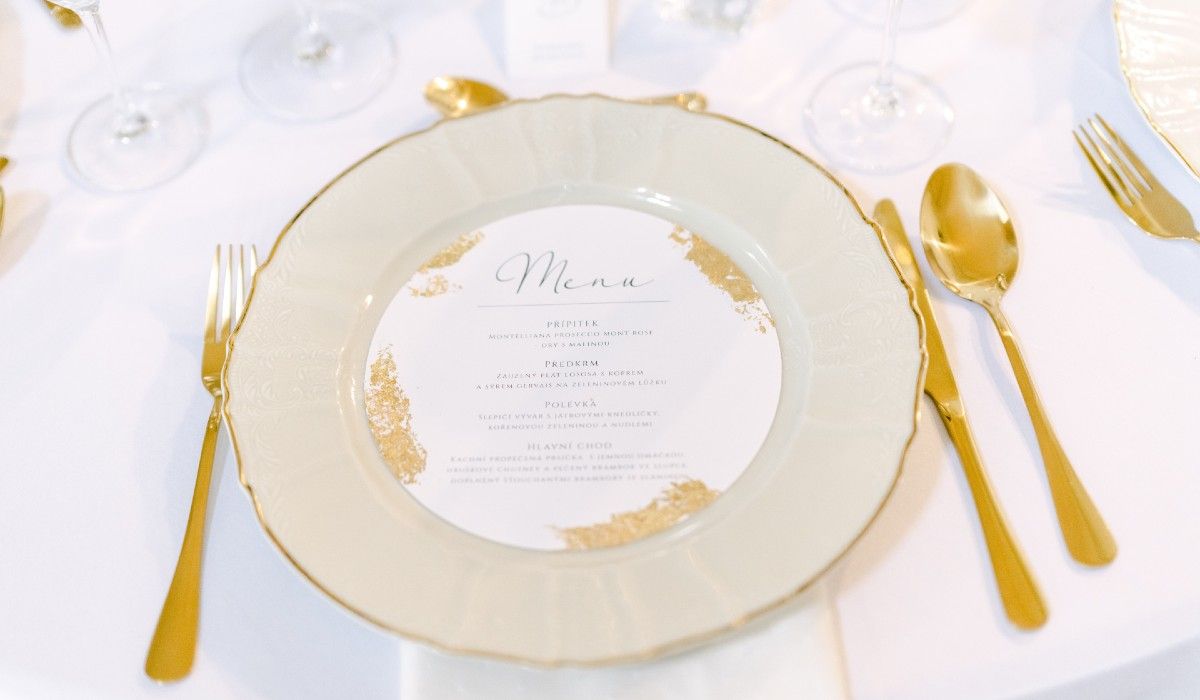
08. 11. 2024 Dining etiquette during different times of the day
Dining is more than just eating together - it's mostly about spending time together during everyday life and during festive moments. And as such, it has its own rules that not only enhance the dining experience, but also add to the atmosphere of the event. And while it might seem that dining etiquette is a thing of the past, it's actually still relevant and hasn't lost its relevance in modern times. So let's take a look at dining etiquette in restaurants, at social events such as wedding dining and other festive dining, as well as the rules of dining during the different meals of the day and the peculiarities of eating certain dishes.
Basic etiquette of proper dining
There are a few basic rules for proper dining. We practice all sneezing and coughing into a handkerchief, moving away from the table towards the less prominent person. If we are seized with a stronger cough or a necessary sniffle, we leave the room. In both cases, we apologize to the others. The woman or the more socially prominent person always begins eating first, then the man. Outside the home, we do not wish each other "good taste." Although a neighbor's food looks tempting, we should not serve it to each other.
Appropriate seating
We always sit upright at the table with our elbows close to our bodies. A woman sits only on the first ⅓ of the chair, with her legs close together and her arms not resting on the back. A man can afford to sit on the entire seat with his legs slightly apart. However, the legs of neither sex may cross under the table.
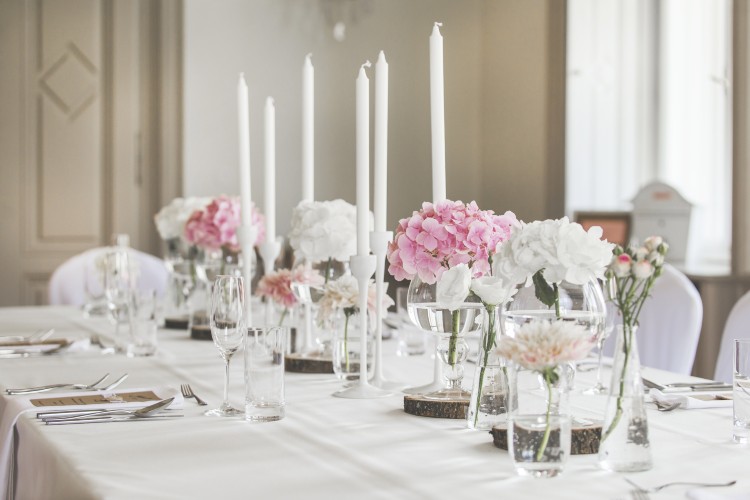
Cloth and paper napkin
K etiketě stolování ubrousky patří. Co ale s nimi? Látkový ubrousek se pokládá ihned po usednutí na klín. V nejlepších podnicích vám jen na klín položí obsluha. Žena ubrousek rozprostře jen z půlky, kdežto muž celý, v obou případech tak, aby plynule navazoval na ubrus. Všimněte si, že ubrousek má rubovou drsnější stranu, díky čemuž hůře sklouzne z klína. Pokud přeci jen spadne, decentně upozorněte obsluhu, přinese vám nový. Ubrousek necháváme během jídla na klíně, či si jím otíráme ústa. Po ukončení konzumace jej složíme tak, aby vzniklé skvrny byly schovány uvnitř, a položíme jej na stůl. Papírový ubrousek odkládáme na stole nejlépe vlevo. Po skončení chodu ho můžeme položit na talíř nebo na stůl, záleží na místní zvyklosti. U nás se však odkládá většinou na talíř.
Getting up from the table
We do not get up from the table while dining. The only valid reason for leaving the table is for health reasons or to go to the toilet. In both cases, we excuse ourselves and, if possible, wait for an appropriate moment. If a woman gets up from the table, her male companion should get up with her.
We translate ourselves
V některých případech se nám může stát, že jídlo nedostaneme naservírované, ale budeme si jej nabírat od číšníků, či nám jej číšník přímo nabere. Obsluha chodí zleva a podle gesta poznáte, jestli si máte nabrat sami nebo vám pokrm nabere obsluha sama. Překládací příbor je složen z lžičky a vidličky, jejichž prohnuté a vypouklé části do sebe zapadají. Mezi střenky vložíme prst, lžící nabereme jídlo a přitiskneme jej vidličkou. Překládací příbor smíme držet také oběma rukama. Po nabrání příbor odložíme zpět na tác, a to vypouklými plochami nahoru, aby šťávy mohly stéct. Svůj talíř necháváme na stole a číšníkovi jej nikdy nepřibližujeme.
Table etiquette and cutlery - how to use them
I když je držení příboru jasné, zopakovat si pravidla stolování s příborem rozhodně neuškodí. Příbor uchopíme tak, aby prsty při držení směřovaly dolů, ukazováčkem tlačíme na horní stranu příboru a konce držadel schováme v dlaních. Ukazováček by měl končit s hranou držadla. Příborem o talíř se zásadně necinká a použitý příbor pokládáme už jedině na talíř. Při jídle nikdy neskláníme hlavu směrem k talíři, ale jídlo vždy doneseme příborem až do úst. Pokud se na stole nachází více příborů, odebíráme je od toho nejvzdálenějšího a postupujeme až k talíři. Pokud nám příbor upadne, necháme jej ležet a nenápadně požádáme obsluhu o nový příbor.
Some dishes can be eaten with just the fork, but at the end of the meal, we put both pieces of cutlery down on the plate. In most cases, we hold the fork with the tines down. For some types of side dishes, we may allow the tines to turn, but the handle of the fork should still be hidden in the palm of the hand.
There is good news for left-handed people. Even in select company, you are allowed to eat with the cutlery in the opposite way to the usual way. The only condition is to put the cutlery down in its usual position at the end so that the waiter can take it away without any problem.
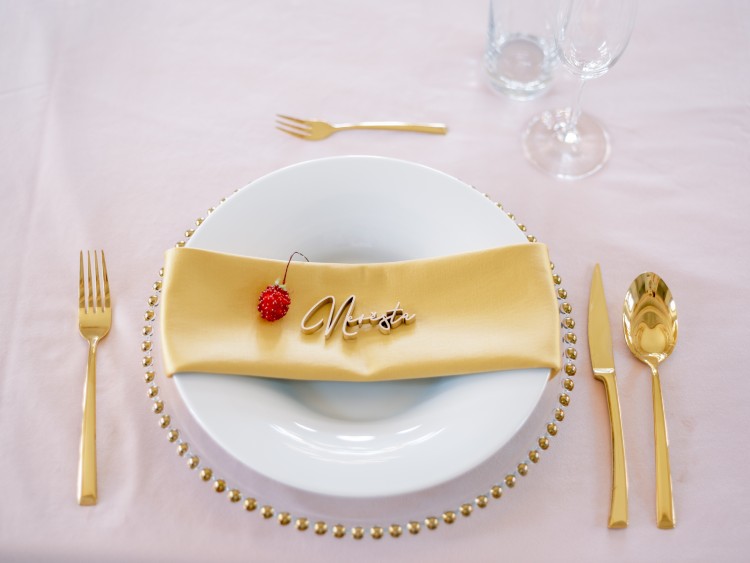
Final cutlery signals
For the sake of order, we will also review the putting away of cutlery and the meaning of these signals:
- Finished: placing the fork tines down parallel and the knife blade to the fork with the tines pointing toward the 16th hour.
- I continue: I put the cutlery down on the plate crossed.
- I want to add: Lay the knife and fork crosswise, with the tines of the fork lying across the blade of the knife.
How does morning etiquette work - catered breakfast and brunch
Morning dining, whether it's a quick breakfast or a leisurely brunch, has its own charm. It's the first moment of the day when we can stop, enjoy a good meal and prepare for what's to come. Breakfast etiquette is usually more relaxed, but certain dining guidelines apply here as well. A social breakfast usually takes place from 9 a.m., whereas brunch doesn't take place until 10 or 10:30 a.m. In both cases, it's usually a buffet form of dining.
We do not serve pastries.
The basis of most breakfasts is the pastry. In good company, the pastry is not bitten off, but broken off with the fingers and then placed in the mouth. This rule also applies if you want to spread butter or spread on the pastry. First break off a piece of pastry, spread it and then place it in the mouth.
Fruits from pineapple to plums
Fruit is also part of the hotel breakfast. Unless there is a finger bowl in the room, you will have to eat the fruit using a fingerless cutlery. So what are the rules for fruit?
- Fruits such as pineapple, mango, kiwi or melon are usually cut into smaller pieces which can be eaten by impaling them on a fork. If the melon is not cut, you can cut it yourself. Kiwi can also be eaten in the usual way by scooping out the flesh with a spoon. The pancakes are transferred from the mouth back to the plate with a spoon.
- The small berries are eaten with a spoon as a compote.
- Place the strawberries in the mouth by the stem, which is then placed on the plate.
- Use a fork to transfer the grapes to your plate. If the grapes are only in a large cluster, cut off a piece with a pair of scissors. If you don't find scissors around, the wine is for decoration and not meant to be eaten.
- The cherries and plums may be eaten with the hands, but the stone should be transferred to the plate with a spoon.
- With avocados, it depends if you get them halved, then you eat them with a spoon, if peeled, you eat them with a fork.
- Examples of problematic fruits include the orange and the banana. For the orange, we first cut the peel with a knife and then separate it from the flesh by inserting the spoon and fork under the peel to make a star shape. We then separate the slices of flesh with the spoon and fork and prick them with the fork.
- For the banana, start by cutting off the ends and cutting the skin lengthways, which you thread onto the fork. Then cut the banana itself into small pieces, which you eat with the fork.
Drinks such as tea or coffee are discussed below at the coffee break.
Work breakfast or brunch
Increasingly, the working lunch is being replaced by a working breakfast or brunch. Clients are usually driven to do this for the following 2 reasons:
- As already mentioned, breakfast is a less formal affair and participants feel more relaxed.
- A meeting at noon breaks up everyone's work day, whereas breakfast can be done early in the morning and by 10am one can fully engage in the normal work process.
- At breakfast, etiquette allows you to talk about the work topic practically from the beginning of the meeting after a few sentences of general conversation.
The basics of dining at lunch
After dinner, lunch is the second most complicated meal of the day. A better lunch menu usually consists of an appetizer, soup, main course, dessert, and appropriate beverages. The general rules of etiquette apply here, of course, but there are also dishes for which etiquette presents us with specific methods.
Soups or broth or cream?
Polévky se servírují buďto v hlubokých talířích (krémy) nebo v miskách (bujóny). V některých restauracích si polévku nabereme sami. V tomto případě k nám číšník přistoupí zleva a přizpůsobí výšku teriny (polévkové mísy) tak, abychom si mohli polévku pohodlně nabrat. Svůj talíř určitě nezvedáme. Horkou polévku nefoukáme, ale počkáme až trochu vychladne. Důležité je nesrkat. Lžíci tedy nasměřujte do úst špičkou. Pokud v polévce máte dlouhé nudle, nakrájejte je lžičkou, abyste předešli případným faux pas. V podniku polévku nevyjídáme do dna, neboť bychom cinkali lžíci o misku. V rodinném kruhu však talíř nakloníme směrem od sebe a polévku dojíme. V případě, že máme bujón naservírovaný v šálku s oušky, můžeme po vyjedení zavářky poslední ⅓ vývaru z misky vypít. U bujónu lžíci nakonec odložíme na podšálek, u krému ji ponecháme v talíři.
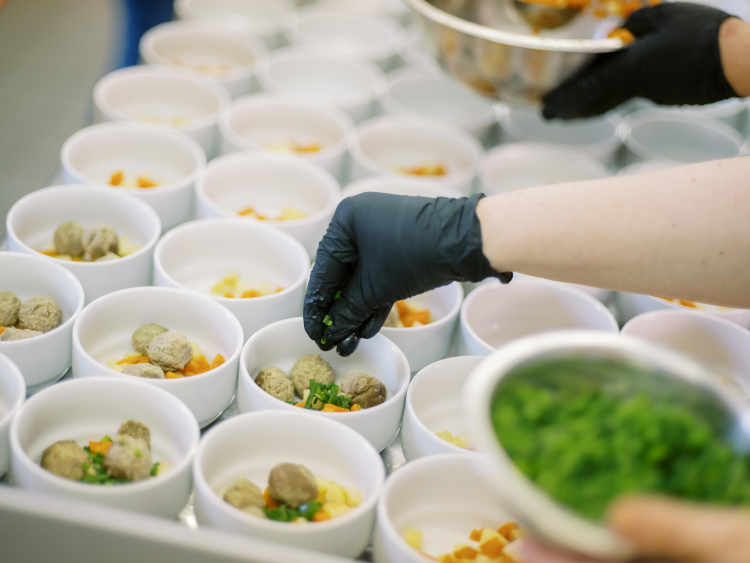
Fish
Na rybu byste měli dostat speciální příbor, tedy vidličku s hlouběji vybraným hrotem uprostřed, která slouží k chycení páteře, a tupý nůž s ostrou špičkou na rozpárání bříška ryby. Rybě nejdřív rozřízneme podélně břicho a rozložíme ji na dvě půlky. Poté sníme rybí líčka (nejlepší a nejjemnější část ryby) a vytáhneme páteř i s ocasem pomocí vidličky. Kousky masa ulpělé na kostech sundáme plochou nože. Následně nožem a vidličkou sundáme kůži, nepoživatelné části odsuneme na okraj talíře, pokapeme rybu citronem a můžeme začít jíst. Rybu ideálně přesuneme z tácu, na kterém byla přinesena, na talíř a doplníme ji přílohou. Pokud talíř navíc nemáme, přidáme přílohu na tác a jíme rybu z tácu. Případné rybí kůstky v ústech vysuneme ke rtům, odebereme vidličkou a umístíme na okraj talíře.

Potatoes, eggs, skewers and other specialties
Brambory bychom správně měli krájet boční stranou vidličky, ne nožem. Do omáčky je přimíchat můžeme, avšak je v žádném případě nerozmačkáváme. Vejce na naměkko umístíme do držáčku, nožem během otáčení držáčku poklepeme na špičku vejce, a nakonec špičku odřízneme i se skořápkou. Vejce následně jíme lžičkou. Stejný postup zopakujeme u vejce natvrdo. Míchaná konzumujeme lžičkou a ham & eggs příborem. Citron napíchneme vidličkou v pravé ruce, levou z něj vymačkáme šťávu a následně ho odložíme. U špízu začneme stažením všech částí z jehly. Hrot jehly zapřeme o talíř, očko přidržíme vidličkou a nožem maso stáhneme. Očko můžeme chytit také rukou pomocí ubrousku v levé ruce a maso sundat vidličkou v pravé. Kuřecí stehno a podobná jídla smíme jíst i rukama, případně rukama s pomocí ubrousku. Avšak příbor je vždy lepší volbou.
.jpg?1731085825509)
Desserts, desserts and ice creams
Most desserts can be eaten with a fork. The exceptions to this are creams and ice creams, which are eaten with a spoon. However, there are special occasions when we need to cut or scoop a dessert, in which case a spoon is used.
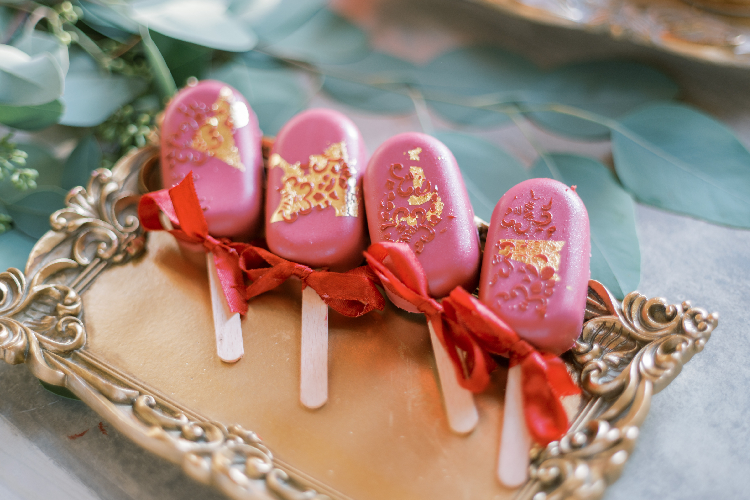
Working lunch
In contrast to a business breakfast, a business lunch is a much more formal affair. In addition to discussing business topics, it is also about establishing a closer relationship and creating a good impression. As hosts, we should arrive before our guest, have everything arranged and ready, and follow all the social rules.
The conversation at lunch should not revolve only around the topic of work, but should give space to other topics. In some cultures, work topics can only be discussed during the breaks between meals, but not at the meal itself. If we get very excited while talking and the other guests have eaten their meals, we cut the last bite and put the food away. We let the guests wait until we have finished eating.
The art of elegance and hospitality at afternoon tea and brunch
A coffee break can be a social event. In addition to coffee and tea, the coffee break menu also includes small snacks such as sandwiches or cakes. Coffee break menus are usually served buffet style, which we will discuss below. However, drinking tea and coffee also has its own rules.
Tea and coffee consumption
If we are sitting at a table, we leave the saucer on the table and drink only from the cup. If we are sitting away from the table, for example in a chair, we lift the cup and saucer from the table. We place the tea bag on a spoon and transfer it to the designated saucer, or use a thread to gently wring it out and place it on the saucer.
The sugar is scooped up with the spoon in the sugar bowl or the sugar cube with the tongs provided. The sugar is stirred inaudibly and the spoon, which is not licked in any way, is placed on the saucer. The teaspoon does not belong in the mouth in good company. However, the foam of a cappuccino or thick chocolate may be tasted with the spoon. Any drop of drink from the spoon on the saucer is not a transgression but a proof of our manners. No drink is drunk with the spoon in the cup. The spoon remains on the saucer when the meal is over.
How to behave at dinner - rules for formal and informal dining
Dinner is definitely the most formal meal of the day. The social rules are the same as we have already said at lunch. However, they are more strictly observed at dinner, to which one must also adapt one's appearance. Soups are usually not served at dinner, but appetizers. If we have pastries for the appetizer, we can help ourselves to them at mealtime, and even wipe the sauce off the plate.
Working dinner
If we are planning a work dinner, expect that conversation should preferably avoid work-related topics. Dinners with clients, vendors, or others in the work environment are primarily for establishing good relationships.
Reception or a welcome glass of wine
A reception is a very specific event with a clearly defined social framework. The reception starts with the arrival itself, when the host himself greets you at the door. It is advisable to bring a small gift with a handwritten tag, hand it over with thanks and proceed further into the hall. Afterwards, a welcome drink awaits you, usually in the form of champagne. Even if you do not drink champagne, you must take a glass according to etiquette, but it is no longer necessary to drink the drink. After all the participants have arrived, the host's speech is followed by a toast, after which the guests knock and converse with each other. You can drink the glass, but you can also put it away or exchange it for a drink that is closer to your taste.
Glasses, wine and sparkling wine
We always holdthe wine glass by the stem. The simple rule is that the colder the drink, the lower we hold the glass. So we hold the sparkling wine at the bottom, the white wine in the middle and the red wine at the top. If you drink from a glass while standing, always take a napkin to hold the glass with all drinks except wine.
Before each drink, finish the bite first and then wipe your mouth. The glass should be put practically to the lips only and drunk in small sips. The cleanliness of the glass is really important on all occasions. We can tap with wine or sparkling wine, but never with an aperitif or digestif. We just lift the glass slightly and indicate a tapping gesture.

Refreshments at the reception
The reception also includes small refreshments, which are eaten standing up, ideally at the edge of the room. You should have a small amount of food on your plate, which is not at risk of social faux pas (getting dirty with sauce, dropping a cucumber from your sandwich, etc.). Biting into a steak skewered on a fork is highly inappropriate. Avoid aromatic foods that would make other guests uncomfortable with our conversation. We hold our canapés by a toothpick. If they do not have a toothpick, we put them in our mouths with one hand, accompanied by a napkin in the other hand.
If you do have an accident and get splashed, go to the toilet and try to clean your clothes. If you fail, you have no choice but to leave the event early. It may also happen that you drop a piece of food on the floor. In this case, do not pick it up, but discreetly alert the attendant, who will clean it up.
When the event is over, say goodbye to the nearest guests and leave. In many cases, however, the reception continues with a buffet or even a banquet.
Etiquette at receptions and buffets
A buffet is one of the most popular ways to consume food today. It can be encountered at a corporate party, a wedding, a birthday party, an event with friends and family, or any other cultural and social event such as a movie premiere or opening night. Banquets, unlike a reception, are usually not initiated and are freely available throughout the course of the event. Hot food, cold food and a cocktail bar are usually available.
At a buffet, always use a folding utensil to scoop up the food. Estimate the quantity so that everything fits comfortably on your plate. Add a few more times rather than letting a piece of food fall on the floor or, heaven forbid, on you. If this happens, follow the same rules as at the reception. You may also encounter fondue at a buffet. Again, use only special forks to scoop up the food. However, a regular fork will do for eating.
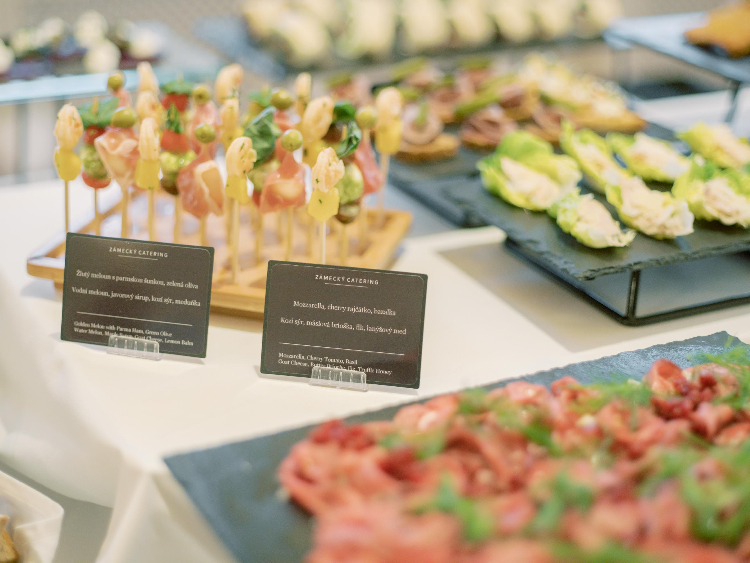
Banquet from seating to digestif
A banquet can be thought of as a very formal meal held for a large number of people for a social occasion. This includes birthday celebrations, political meetings, but also congresses and conferences. For this event, you should more than observe all the social rules, which already include arriving at the hall and then being seated.
Seating at the banquet
The banquet usually begins in a separate room where the digestif is served. The banquet servers first introduce the ladies to the banquet tables, then the hostess, then the men, and finally the host and the chief guest. However, there are banquets with a reverse seating order, or a more separate seating system based on name cards. Everyone in the room remains standing at the back of the banquet chair and waits for the hostess to be seated. In the meantime, it is appropriate to introduce oneself either to the entire smaller table or to the neighbors at the larger table. Thus, the hostess is seated first, then the ladies, and then the gentlemen.
Banquet toasts
The banquet is opened with a joint toast given by the host in honour of the chief guest. The host then raises his goblet (he and the guest are allowed to knock) and raises it towards the hall. The guests in the hall stand up, raise their goblets towards the host and chief guest, toast and applaud. The guest makes his speech either now or at the end of the evening. The process of gestures is repeated again.
Banquet and Catering
The banquet begins as soon as the hostess places her napkin on her lap. At this point, it is possible to take a drink of water and take the banquet pastries. The dishes served from the banquet menu can be started after the hostess has finished eating. We adjust the pace to suit the others, as debaras (taking away used dishes) is always done in bulk. If we don't like the food, we just "unwrap" it subtly so that it at least looks like we have eaten. The end of the banquet comes when the host and hostess stand up.
The best catering from Chateau Catering
You can turn to our catering service when organizing any social event, whether it be the aforementioned banquet or birthday party catering, banquet catering and service, as well as a wedding or garden party. For every occasion, we will put together the perfect combination of dishes that not only you, but also your guests will appreciate. We will take care of creating a wedding menu, but we will also prepare a wedding buffet instead of a luncheon. For true gourmets, we offer experiential gastronomy in the form of fine dining. In addition to food preparation and service, we will also provide you with a pleasant environment in the castle Karlova Koruna, Dobřenice, Kačina, Hrádek u Nechanic, or any other hall or place from our beautiful locations.
You can find inspiration for your events in our references or on our blog. By choosing a good catering company you can easily make an ordinary event an extraordinary experience. We believe that we will become your favourites. Send us a non-binding inquiry or contact us on +420 601 301 601 or via e-mail info@zamecky-catering.cz.
Article content
- General rules of social behaviour at the table
- Appropriate seating
- Where to go with a cloth and paper napkin
- Rules of leaving the table
- Scooping your food
- How to use a spoon, fork, and knife
- Ending a meal with cutlery signals
- Breakfast and brunch etiquette
- Rules for eating baked goods
- Etiquette when eating fruit
- How to behave at a business breakfast
- Formal and informal lunches and rules of etiquette
- Broths and creams
- Fish
- Lemon, skewer, potatoes, and other dishes
- Desserts and desserts
- Lunch in a work environment
- Coffee break
- Tea and coffee rules
- Dinner by etiquette
- Working dinner
- Reception from opening to leaving
- Wine, sparkling wine and other alcohol
- Eating food standing up
- Banquets and buffets for all social events
- Banquet catering
- Banquet seating
- Banquet toasting rules
- How to eat banquet steaks, pastries and desserts
- Chateau catering as the first choice when choosing a catering company
Categories of the blog
Tags from the blog
More articles from the blog
The wedding day should be full of joy, laughter and unforgettable experiences. A well thought out wedding programme will keep the atmosphere up, engage your guests and add a unique touch to your day. Take inspiration from traditional customs, popular wedding games and original ideas to turn your wedding into an unforgettable event.

Tips for the wedding 17. 06. 2025 Wedding in a church
Are you planning a wedding and considering a church ceremony? Whether you desire a spiritual dimension, a historic atmosphere or simply a beautiful setting, a church wedding may be just the ticket. In this article, we explain the difference between a church and a civil marriage, find out what the requirements are for a church wedding and give you advice on how to plan everything practically.

